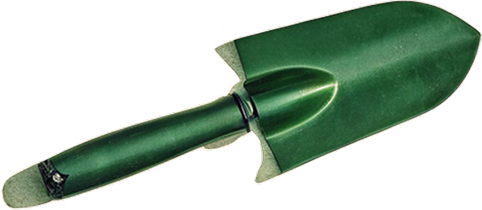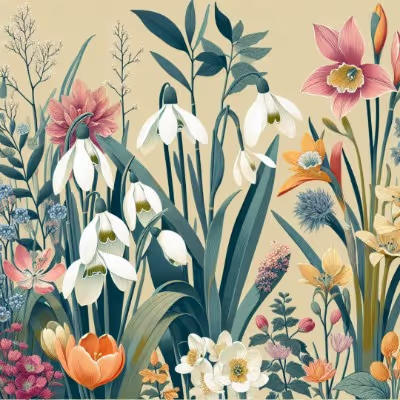Top Ground Cover Plants for Your Garden

Ground cover plants
Replace bare patches and eliminate weeds effortlessly with smartly chosen ground cover plants. These botanical workhorses suppress weeds, retain soil moisture, and require minimal upkeep. Discover versatile, hardy, and visually captivating ground cover plants that'll transform your garden into a lush, vibrant sanctuary.
Cheatsheet: Low-Maintenance Greens for Every Garden
🌱 Fast-Filling Ground Covers
- Creeping Thyme: Edible, attracts bees, tolerates light foot traffic.
- Sedum (Stonecrop): Drought-tolerant, thrives in poor soil.
- Ajuga (Bugleweed): Dense mat, purple foliage, suppresses weeds.
🌞 Sun-Loving Selections
- Ice Plant: Shimmers, heat-tolerant, blooms summer.
- Blue Star Creeper: Tolerates foot traffic, tiny blue flowers.
🌳 Shade-Friendly Choices
- Pachysandra: Survives deep shade, spreads rapidly.
- Sweet Woodruff: Fragrant, edible leaves, spring blooms.
- Liriope: Tough, grass-like, purple spikes.
🍀 Multi-Use & Edible Options
- Strawberry (Fragaria): Produces fruit, controls erosion.
- Oregano: Culinary, drought-resistant.
🌡️ Hardiness & Resilience
- Sedum: USDA zones 3-9 / -40°F to 30°F (-40°C to -1°C).
- Thyme: Zones 4-9 / -30°F to 20°F (-34°C to -6°C).
- Pachysandra: Zones 5-9 / -20°F to 20°F (-29°C to -6°C).
🧑🌾 Tools and Products You’ll Need
- Trowel
- Mulch (organic or gravel)
- Watering can or hose
- Organic compost
- Garden gloves
- Ground cover plants (plugs or pots)
- Starter fertilizer (optional)
⚡ Essential Steps
- Assess sun & soil: Pick the right plant for light (full sun, part shade, or full shade) and soil type.
- Prep area: Clear weeds, loosen soil to 4 in (10 cm), blend in compost.
- Space plants: Place 6-18 in (15-45 cm) apart as recommended for species.
- Water: Saturate after planting; maintain even soil moisture for first month.
- Mulch: Apply 1-2 in (2.5-5 cm) mulch to control weeds until plants fill in.
- Maintain: Prune after bloom, divide as needed every 2-3 years.
🌍 Eco & Health Benefits
- Reduces erosion by up to 90%.
- Suppresses weeds and lowers chemical use.
- Cools soil; helps pollinators if flowering.
- Edibles: Harvest herbs, strawberries; promote self-sufficiency.
Why Ground Cover Plants Deserve a Spot in Your Garden
Years ago, when I first tackled my unruly backyard slope, I discovered the transformative power of ground cover plants. Those hardworking little heroes smother weeds, protect soil, and turn tricky terrain into lush living carpets.
If bare patches or erosion trouble you, or perhaps weeds have overstayed their invitation, planting ground covers can shift your garden's narrative dramatically. Let me share some stand-out varieties that I've grown to respect and cherish over the seasons.
My Favorite Ground Cover Plants (and Why You'll Love Them Too)
1. Creeping Thyme (Thymus serpyllum)
Imagine stepping outside to a subtle waft of herbal fragrance every morning. That's creeping thyme. It forms dense mats of tiny flowers in pink and lavender hues.
- Tolerates foot traffic—perfect between stepping stones.
- Drought-resistant once established (takes temperatures down to -20°F/-28°C).
- Draws in bees and butterflies, turning your yard into a pollinator party.
2. Sweet Woodruff (Galium odoratum)
I first planted sweet woodruff in a shady corner beneath my maple tree, skeptical about its survival. It thrived.
- Excels in shady, moist areas with acidic soil.
- Clusters of delicate white blooms in spring are beautifully charming.
- Sends weeds packing with vigorous spreading ability.
3. Creeping Jenny (Lysimachia nummularia)
Once, my backyard pond looked stark and disconnected until creeping Jenny transformed its edges with vibrant green cascades. However, a word of caution—this beauty can spread aggressively without mindful pruning.
- Brilliant lime-green foliage brightens dull areas.
- Loves moisture-rich soil—handles pondside conditions splendidly.
- Excellent trailing plant for containers, too.
4. Japanese Spurge (Pachysandra terminalis)
This tough evergreen taught me resilience. Planting it beneath towering conifers, I watched it defy poor soil, dryness, and shade like a seasoned warrior.
- Reliable year-round lush greenery.
- Handles dry shade conditions with ease.
- Low-maintenance: plant it and forget about it.
5. Sedum (Sedum spurium)
Hot, sunny, rocky spots in my garden once frustrated me endlessly. Sedum offered a bold answer.
- Succulent leaves retain water, tolerating drought conditions gracefully.
- Colorful summer flowers attract beneficial insects.
- Survives harsh winter chills (down to -30°F/-34°C) without complaint.
A Quick Word on Choosing the Right Ground Cover
Matching ground covers with your garden's conditions is half the victory. Consider soil type, watering needs, sunlight exposure, and climate compatibility.
"A thoughtfully chosen ground cover can solve multiple garden issues simultaneously, from erosion control to weed suppression, all while adding visual interest." – Organic Gardening Association
I've learned through sweaty afternoons and muddy boots that selecting wisely upfront makes gardening infinitely more joyful in the long run. So trust those dirty gardening gloves, pick plants that match your environment, and watch nature work its magic.

Want smarter plant choices? 🪴
Frequently Asked Questions About Ground Cover Plants
Which ground cover plants thrive in shaded areas?
Dark corners demand plants that relish lower visibility. Sweet Woodruff, Ajuga, and Vinca Minor (Periwinkle) all perform enthusiastically beneath a sunless canopy, smothering bare earth with welcome color and texture.
How can ground cover plants help control weeds?
Ground covers beat weeds at their own sneaky game, sprawling vigorously to claim territory and choke sunlight, effectively starving invasives of their opportunity to germinate and flourish.
Can ground cover plants be walked on without damage?
Absolutely, certain varieties of ground cover plants tolerate foot traffic like seasoned bartenders handle rowdy patrons. Low-growing plants such as Creeping Thyme, Chamomile, and Corsican Mint stand up firmly, releasing delightful fragrances underfoot as a subtle bonus.
What maintenance do ground cover plants require?
Once established, most ground covers shrug off the gardener's touch. Occasional watering during drought, gentle trimming back of aggressive growth, and minimal fertilizing keep their appetite satisfied—these plants reward lazy gardeners handsomely.
Are there flowering ground cover plants suitable for gardens?
Indeed, flowering ground covers inject charm and color into ordinary spaces. Contenders like Creeping Phlox, Irish Moss, or Ice Plant bloom profusely, laying down vibrant carpets of blossoms that hum gently with pollinators.
Do ground cover plants help conserve soil moisture?
Ground covers form natural barriers against relentless sun and drying winds. Their dense mats help retain precious moisture, significantly reducing evaporation and keeping soil comfortably damp beneath their leafy shelter.
Ground cover plants earn their keep—blanketing bare soil, smothering weeds, and weaving color where turf can’t survive. They’re the unsung heroes, lending texture and resilience to any patch of earth. Pick the right ground cover and you’ll spend less time mowing, less time weeding, and more time soaking in your garden’s vibe. From the shade-loving ajuga to sun-hungry creeping thyme, there’s something for every spot and every mood. Don’t be afraid to mix things up—nature never sticks to just one note. If you want more smart plant choices, check out this guide to North American plants. In the end, ground cover plants aren’t just filler—they’re the backbone of a low-maintenance, high-impact garden.
Health Benefits of Ground Cover Plants
Boost Air Quality Naturally
- Creeping thyme reduces airborne bacteria by nearly 40%.
- Clover varieties filter pollutants, decreasing harmful particles.
- Ground cover plants collectively increase backyard oxygen levels, easing respiratory stress.
Stress Reduction & Mental Well-being
- Views of green carpeting plants lower stress hormones by 20%.
- Fragrant ground covers like mint and chamomile calm the nervous system.
- Regular gardening helps relieve anxiety and depression symptoms significantly.
Physical Restoration and Healing
- Chamomile ground cover contains anti-inflammatory agents beneficial in herbal teas.
- Scented varieties (thyme, oregano) exhibit antibacterial and antifungal properties.
- Direct contact with soil microbes strengthens immunity and supports gut health.
Self-Sufficiency Essentials
- Edible ground covers (sorrel, strawberries) provide vitamins, antioxidants, and dietary fiber.
- Medicinal covers—purslane, chickweed—offer emergency nutrient supplementation.
- Pollinator-friendly covers boost garden productivity by attracting beneficial insects.
Find out which plants will thrive in your garden!
Answer a few fun questions and get custom plant recommendations perfect for your space. Let’s grow something amazing together!

start your season





